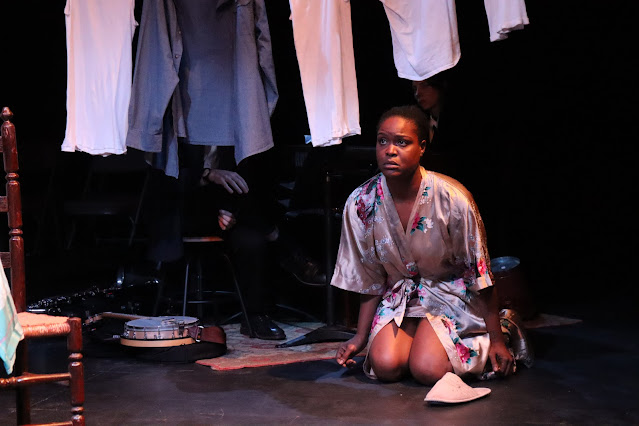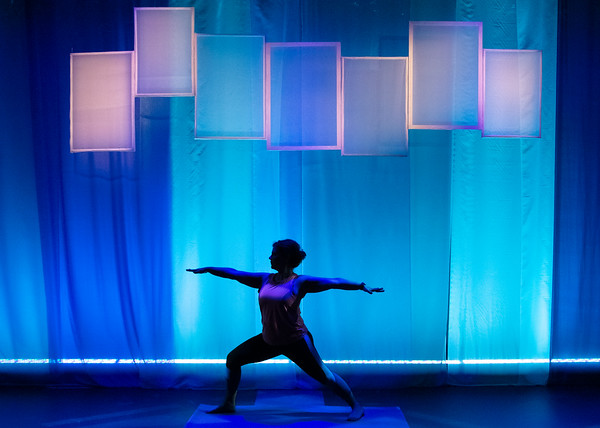Point Loma
Written by Tim Mulligan
Directed by Ken Wolf
312 W. 36th Street, 3rd fl., Manhattan, NYC
May 31-June 15, 2025
 |
| Parker Jenkins and Jessica Luhmann. Photo by Chris Bentley. |
In his recent book
The Ethics of Horror (Lexington Books, 2024), Michael J. Burke argues for a distinction between traditional haunting films, in which specters seek some kind of restitution and ultimately, thanks to and along with the living protagonist(s), achieve closure, and a more recent strain that he terms phantom persecution films, in which the ethical debt to the spirit(s) can never be paid and closure remains forever out of reach. If we transpose these categories to the stage, Tim Mulligan's haunted-house play
Point Loma, making its world premiere at the Chain this month, does not completely fit either–or maybe more precisely, shifts from one of them to the other–much to its advantage. Mulligan, also author of the
World of Witchland graphic novels and the
A Perfect 10 cookbooks, took inspiration for Point Loma from
events that he has experienced in a historic home occupied by good friends of his in the San Diego community from which the play's title derives. The Point Loma area, as comes to figure in the play's story, has long been home to US naval facilities, consolidated in 1998 into Naval Base Point Loma, and its history as a military outpost stretches back to the Spanish Fort Guijarros fort, erected in the late eighteenth century. Mulligan's previous play,
Witchland (you can read our review
here), also linked spooky goings-on to West-coast history, and
Point Loma, like that earlier play, effectively and entertainingly interlaces fun and humor with its jump scares and creepiness.
 |
| Jevon Nicholson and Michelle Park. Photo by Chris Bentley. |
As the play opens, the walls and furniture of the set are draped in white sheets, a haunted house where mediumistic Kim (Michelle Park) and camera/soundman Carl (Mathew Hernandez) from the podcast
Ghosting are about to experience more than they bargained for, while Rick (Jevon Nicholson), the third member of the
Ghosting team, hosts from back in the studio. When the lights come up again following the scares of the dimly lit, red-tinged opening scene, the set has been denuded of its coverings, transforming it into the bright white kitchen of a house belonging to an older man named Hank (Dave Silberger), whose Art Deco home boasts a historic designation from the city of San Diego. Hank has been in a coma for months–the production smartly uses the raised landing in front of the first row of audience seats as his upstairs bedroom, along with other locations–and while assertively cheerful VA nurse Anna (Jessica Luhmann) has been sticking it out on the day shift as Hank's home health aide, turnover on the night shift has been very frequent, as Anna informs new night nurse Chad (
Parker Jenkins). It doesn't take long to see why, as loud noises of unknown origin quickly give way to further spectral phenomena. And then there's that door to the cellar. As Chad's experiences escalate, we see Rick, clad in a succession of horror-film tees, try to push Kim past her disenchantment with the supernatural, stemming from her traumatic experience in the opening scene, and we meet Chad's ghost–and
Ghosting–loving boyfriend, Todd (a very funny Ian Brady). It is through Todd that all of our characters, with varying degrees of reluctance, come together at Hank's home to try to learn what haunts it and why.
 |
| Ian Brady and Parker Jenkins. Photo by Chris Bentley. |
By the final scene, the play's well-seeded hints and plot threads have come satisfyingly together as well. Thematically, the why of the haunting can be linked to institutional ignorance or/and secrecy and male power, the resilience shown by single mother Anna and learned by Chad is inextricable from their need to earn a living, much as Rick's initial lack of empathy for Kim's experience is connected to his drive to ensure the podcast's continued success–whether chasing shift work or ratings, money pressures can be their own form of inescapable haunting. The actual haunting is skillfully manifested through a mix of actors (Chelsea Clark, Nathan Cusson, and Patricia Griffith), well conceived practical effects, and great sound design. Some of the scares are subtle, others less so; and with the latter, as is generally the case in the horror genre, character reactions to scary events help to establish and intensify the fear factor and occasionally the humor–a challenge more than met by the cast here, who are equally commendable in their non-supernatural, character-driven moments, whether Luhmann as Anna giving in to the stress of working in the house with a bottle of vodka, Park as Kim and Nicholson as Rick tensely and vulnerably negotiating their professional and non-professional relationships simultaneously, or Brady as Todd sharing a warm, flirty, calm-before-the-storm moment with Jenkins as Chad in that haunted kitchen. In the same scene, Todd refers to what's going on in the house as "
Poltergeist times 20," and the Tobe Hooper-directed film is not a bad tonal comparison for
Point Loma–but to really judge, you need–like Rick does to really understand Kim–to pay a visit to Hank's house yourself.
-John R. Ziegler and Leah Richards






Comments
Post a Comment